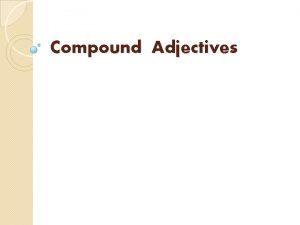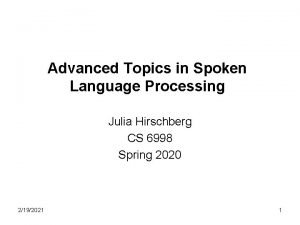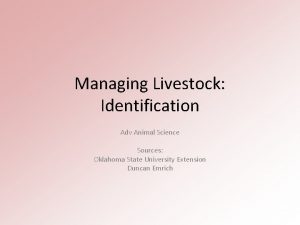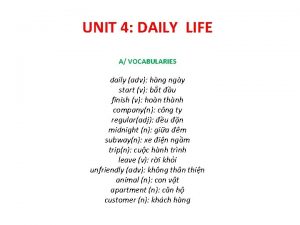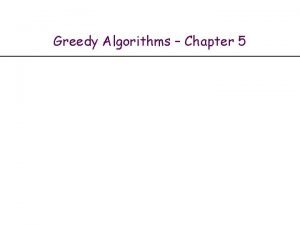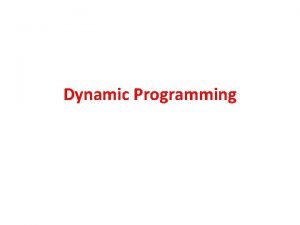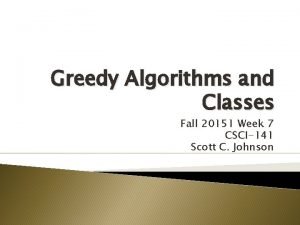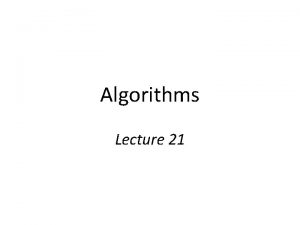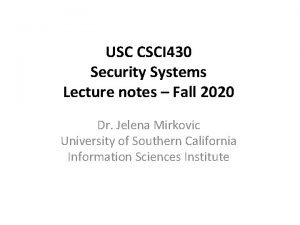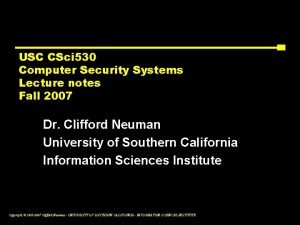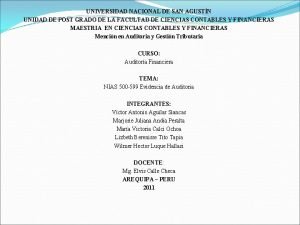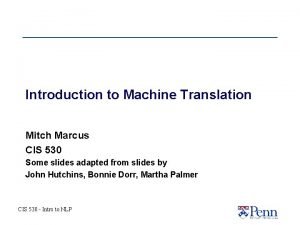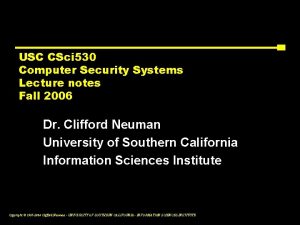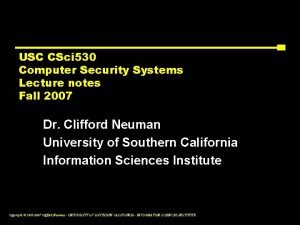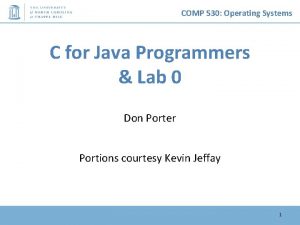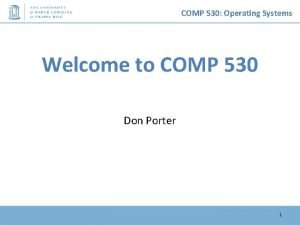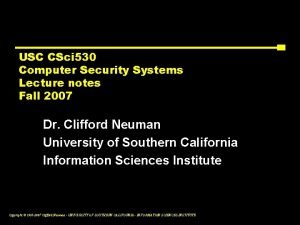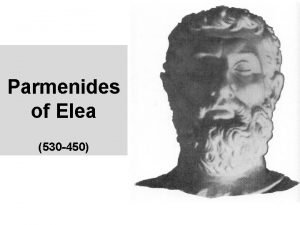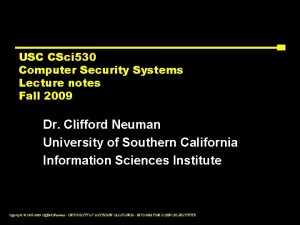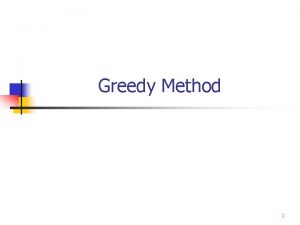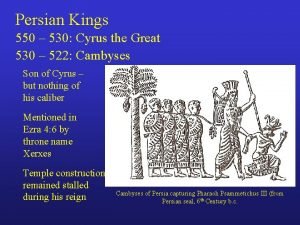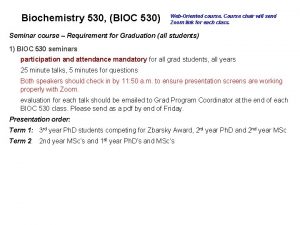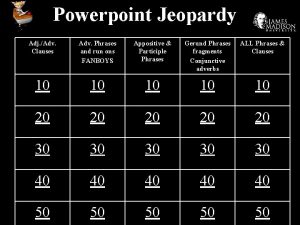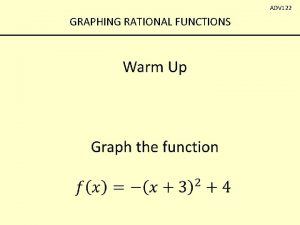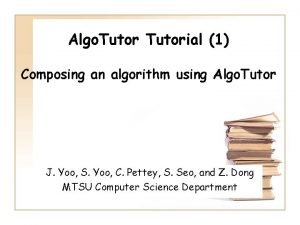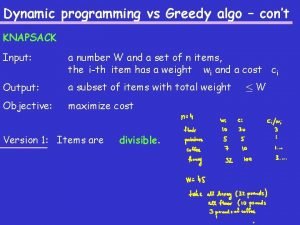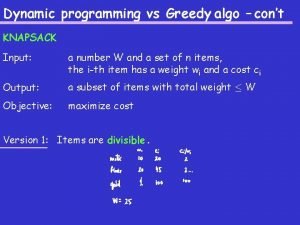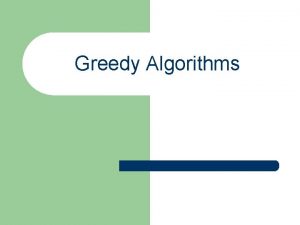The Greedy Approach Young CS 530 Adv Algo









































- Slides: 41

The Greedy Approach Young CS 530 Adv. Algo. Greedy 1

General idea: Given a problem with n inputs, we are required to obtain a subset that maximizes or minimizes a given objective function subject to some constraints. Feasible solution — any subset that satisfies some constraints Optimal solution — a feasible solution that maximizes or minimizes the objective function Young CS 530 Adv. Algo. Greedy 2

procedure Greedy (A, n) begin solution Ø; for i 1 to n do x Select (A); // based on the objective // function if Feasible (solution, x), then solution Union (solution, x); end; Select: A greedy procedure, based on a given objective function, which selects input from A, removes it and assigns its value to x. Feasible: A boolean function to decide if x can be included into solution vector (without violating any given constraint). Young CS 530 Adv. Algo. Greedy 3

About Greedy method The n inputs are ordered by some selection procedure which is based on some optimization measures. It works in stages, considering one input at a time. At each stage, a decision is made regarding whether or not a particular input is in an optimal solution. Young CS 530 Adv. Algo. Greedy 4

1. Minimum Spanning Tree ( For Undirected Graph) The problem: 1) Tree A Tree is connected graph with no cycles. 2) Spanning Tree A Spanning Tree of G is a tree which contains all vertices in G. Example: G: Young CS 530 Adv. Algo. Greedy 5

b) Is G a Spanning Tree? Key: Yes Key: No Note: Connected graph with n vertices and exactly n – 1 edges is Spanning Tree. 3) Minimum Spanning Tree Assign weight to each edge of G, then Minimum Spanning Tree is the Spanning Tree with minimum total weight. Young CS 530 Adv. Algo. Greedy 6

Example: a) Edges have the same weight 1 G: 2 4 3 6 5 7 8 Young CS 530 Adv. Algo. Greedy 7

§ DFS (Depth First Search) 1 7 2 3 5 4 6 8 Young CS 530 Adv. Algo. Greedy 8

§ BFS (Breadth First Search) 1 2 4 3 5 6 7 8 Young CS 530 Adv. Algo. Greedy 9

b) Edges have different weights c) 16 1 d) G: 21 11 6 19 33 DFS 3 6 14 10 18 16 1 5 4 5 § 2 2 5 6 33 5 Young CS 530 Adv. Algo. 3 14 4 10 Greedy 10

§ BFS 1 16 5 2 21 3 6 19 6 4 5 § Minimum Spanning Tree (with the least total weight) 1 16 5 2 11 6 Young CS 530 Adv. Algo. 6 3 18 4 5 Greedy 11

Algorithms: 1) Prim’s Algorithm (Minimum Spanning Tree) 2) 3) Basic idea: Start from vertex 1 and let T Ø (T will contain all edges in the S. T. ); the next edge to be included in T is the minimum cost edge(u, v), s. t. u is in the tree and v is not. 4) 5) Example: G 16 1 21 11 6 19 33 5 3 6 14 4 5 Young CS 530 Adv. Algo. 2 10 18 Greedy 12

1 16 2 (Spanning Tree) 19 21 5 6 S. T. 1 2 1 19 10 4 6 2 6 5 5 21 6 4 S. T. 1 2 3 4 18 14 2 11 6 3 1 3 4 2 21 5 11 6 6 S. T. 19 21 5 1 19 1 6 5 2 3 S. T. 4 Young CS 530 Adv. Algo. Greedy 13

1 2 4 3 19 18 5 5 1 2 S. T. 6 33 2 4 5 3 6 5 Cost = 16+5+6+11+18=56 Minimum Spanning Tree 3 S. T. 4 1 6 (n – # of vertices, e – # of edges) It takes O(n) steps. Each step takes O(e) and e n(n-1)/2 Therefore, it takes O(n 3) time. With clever data structure, it can be implemented in O(n 2). Young CS 530 Adv. Algo. Greedy 14

2) Kruskal’s Algorithm Basic idea: Don’t care if T is a tree or not in the intermediate stage, as long as the including of a new edge will not create a cycle, we include the minimum cost edge Example: 30 1 45 Step 1: Sort all of edges 4 (1, 2) 10 √ (3, 6) 15 √ 20 6 (4, 6) 20 √ (2, 6) 25 √ (1, 4) 30 × reject create cycle (3, 5) 35 √ Young CS 530 Adv. Algo. Greedy 10 2 25 50 3 40 35 55 5 15 15

Step 2: T 1 2 2 1 1 1 2 3 6 4 2 3 6 4 5 Young CS 530 Adv. Algo. Greedy 16

How to check: adding an edge will create a cycle or not? If Maintain a set for each group (initially each node represents a set) Ex: set 1 set 2 1 2 new edge 2 3 6 set 3 4 5 6 from different groups no cycle created Data structure to store sets so that: i. The group number can be easily found, and ii. Two sets can be easily merged Young CS 530 Adv. Algo. Greedy 17

Kruskal’s algorithm While (T contains fewer than n-1 edges) and (E ) do Begin Choose an edge (v, w) from E of lowest cost; Delete (v, w) from E; If (v, w) does not create a cycle in T then add (v, w) to T else discard (v, w); End; With clever data structure, it can be implemented in O(e log e). Young CS 530 Adv. Algo. Greedy 18

So, complexity of Kruskal is 3) Comparing Prim’s Algorithm with Kruskal’s Algorithm i. Prim’s complexity is ii. Kruskal’s complexity is if G is a complete (dense) graph, Kruskal’s complexity is . if G is a sparse graph, Kruskal’s complexity is Young CS 530 Adv. Algo. Greedy 19

2. Dijkstra’s Algorithm for Single-Source Shortest Paths The problem: Given directed graph G = (V, E), a weight for each edge in G, a source node v 0, Goal: determine the (length of) shortest paths from v 0 to all the remaining vertices in G Def: Length of the path: Sum of the weight of the edges Observation: May have more than 1 paths between w and x (y and z) But each individual path must be minimal length (in order to form an overall shortest path form v 0 to vi ) w x y z V 0 Young CS 530 Adv. Algo. shortest paths from v 0 to vi Greedy Vi 20

Notation cost adjacency matrix Cost, 1 a, b V cost from vertex i to vertex j if there is a edge Cost (a, b) = 0 if a = b otherwise 1 if shortest path (v, w) is defined s(w) = 0 otherwise in the vertex set V = the length of the shortest path from v to j if i is the predecessor of j along the shortest path from v to j Young CS 530 Adv. Algo. Greedy 21

45 Example: 50 V 1 V 4 35 15 10 10 20 20 V 2 V 3 15 30 3 V 5 a) Cost adjacent matrix Young CS 530 Adv. Algo. Greedy 22

b) Steps in Dijkstra’s Algorithm 1. Dist (v 0) = 0, From (v 0) = v 0 2. Dist (v 2) = 10, From (v 2) = v 0 45 45 V 0 50 10 V 1 50 V 4 V 1 10 V 4 15 20 10 15 35 10 20 20 35 20 30 30 V 2 15 Young CS 530 Adv. Algo. V 3 3 V 2 V 5 Greedy 15 V 3 3 V 5 23

3. Dist (v 3) = 25, From (v 3) = v 2 4. Dist (v 1) = 45, From (v 1) = v 3 45 50 V 1 15 20 10 45 10 V 4 50 V 0 15 35 20 20 15 Young CS 530 Adv. Algo. V 3 3 V 5 Greedy 10 V 4 35 10 20 30 V 2 V 1 V 2 15 V 3 30 3 V 5 24

5. Dist (v 4) = 45, From (v 4) = v 0 6. Dist (5) = 45 45 V 0 50 V 1 15 20 10 10 50 V 4 V 1 15 35 20 20 10 10 V 4 35 20 30 30 V 2 15 Young CS 530 Adv. Algo. V 3 3 V 5 V 2 Greedy 15 V 3 V 5 3 25

c) Shortest paths from source v 0 v 2 v 3 v 1 45 v 0 v 2 10 v 0 v 2 v 3 25 v 0 v 4 45 v 0 v 5 Young CS 530 Adv. Algo. Greedy 26

Dijkstra’s algorithm: procedure Dijkstra (Cost, n, v, Dist, From) // Cost, n, v are input, Dist, From are output begin for i 1 to n do for num 1 to (n – 1) do choose u s. t. s(u) = 0 and Dist(u) is minimum; for all w with s(w) = 0 do if end; Young CS 530 Adv. Algo. Greedy (cont. next page) 27

Ex: 1 10 50 30 100 5 2 20 10 4 50 5 3 a) Cost adjacent matrix Young CS 530 Adv. Algo. Greedy 28

b) Steps in Dijkstra’s algorithm c) 1. Dist (1) = 0, From (1) = 1 2. Dist (5) = 10, From (5) = 1 10 5 50 10 30 100 2 20 10 5 4 Young CS 530 Adv. Algo. 50 5 50 30 100 20 10 4 3 50 Greedy 2 5 3 29

3. Dist (4) = 20, From (4) = 5 4. Dist (3) = 30, From (3) = 1 10 4 50 Shortest paths from source 1 1 5 10 Young CS 530 Adv. Algo. 5 2 20 10 3 4 5. Dist (2) = 35, From (2) = 3 10 30 1 5 4 20 30 50 5 3 1 1 3 2 35 1 3 50 100 2 5 20 10 30 100 5 10 50 5 50 30 100 2 20 10 4 Greedy 50 5 3 30

3. Optimal Storage on Tapes The problem: Given n programs to be stored on tape, the lengths of these n programs are l 1, l 2 , . . . , ln respectively. Suppose the programs are stored in the order of i 1, i 2 , . . . , in Let tj be the time to retrieve program ij. Assume that the tape is initially positioned at the beginning. tj is proportional to the sum of all lengths of programs stored in front of the program ij. Young CS 530 Adv. Algo. Greedy 31

The goal is to minimize MRT (Mean Retrieval Time), i. e. want to minimize Ex: There are n! = 6 possible orderings for storing them. order total retrieval time MRT 1 2 3 4 5 6 1 2 3 1 3 2 2 1 3 2 3 1 2 3 2 1 5+(5+10)+(5+10+3)=38 5+(5+3)+(5+3+10)=31 10+(10+5)+(10+5+3)=43 10+(10+3)+(10+3+5)=41 3+(3+5)+(3+5+10)=29 3+(3+10)+(3+10+5)=34 38/3 31/3 43/3 41/3 29/3 34/3 Smallest Note: The problem can be solved using greedy strategy, just always let the shortest program goes first. ( Can simply get the right order by using any sorting algorithm) Young CS 530 Adv. Algo. Greedy 32

Analysis: Try all combination: O( n! ) Shortest-length-First Greedy method: O (nlogn) Shortest-length-First Greedy method: Sort the programs s. t. and call this ordering L. Next is to show that the ordering L is the best Proof by contradiction: Suppose Greedy ordering L is not optimal, then there exists some other permutation I that is optimal. I = (i 1, i 2, … in) a < b, s. t. (otherwise I = L) Young CS 530 Adv. Algo. Greedy 33

Interchange ia and ib in and call the new list I : x I … ia ia+1 ia+2 … ib … … ia … SWAP I … ib ia+1 ia+2 x In I , Program ia+1 will take less (lia- lib) time than in I to be retrieved In fact, each program ia+1 , …, ib-1 will take less (lia- lib) time For ib, the retrieval time decreases x + lia For ia, the retrieval time increases x + lib Therefore, greedy ordering L is optimal Young CS 530 Adv. Algo. Greedy Contradiction!! 34

4. Knapsack Problem The problem: Given a knapsack with a certain capacity M, n objects, are to be put into the knapsack, each has a weight and a profit if put in the knapsack . The goal is find where s. t. is maximized and Note: All objects can break into small pieces or xi can be any fraction between 0 and 1. Young CS 530 Adv. Algo. Greedy 35

Example: Greedy Strategy#1: Profits are ordered in nonincreasing order (1, 2, 3) Young CS 530 Adv. Algo. Greedy 36

Greedy Strategy#2: Weights are ordered in nondecreasing order (3, 2, 1) Greedy Strategy#3: p/w are ordered in nonincreasing order (2, 3, 1) Optimal solution Young CS 530 Adv. Algo. Greedy 37

Analysis: Sort the p/w, such that Show that the ordering is the best. Proof by contradiction: Given some knapsack instance Suppose the objects are ordered s. t. let the greedy solution be Show that this ordering is optimal Case 1: it’s optimal Case 2: s. t. where Young CS 530 Adv. Algo. Greedy 38

Assume X is not optimal, and then there exists s. t. and Y is optimal examine X and Y, let yk be the 1 st one in Y that yk xk yk < xk same Now we increase yk to xk and decrease as many of as necessary, so that the capacity is still M. Young CS 530 Adv. Algo. Greedy 39

Let this new solution be where 0 Young CS 530 Adv. Algo. Greedy 40

So, if else (Repeat the same process. At the end, Y can be transformed into X. X is also optimal. Contradiction! ) Young CS 530 Adv. Algo. Greedy 41
 Adj-ned
Adj-ned Enjoyment verb
Enjoyment verb Adv spoken language processing
Adv spoken language processing Adv animal science
Adv animal science R rel adv
R rel adv Adv report
Adv report Med adv rppo
Med adv rppo Adv vinod sampat
Adv vinod sampat Daily adv
Daily adv Interval scheduling greedy algorithm
Interval scheduling greedy algorithm Divide and conquer vs greedy
Divide and conquer vs greedy Greedy bank method
Greedy bank method Greedy approach
Greedy approach Greedy approach
Greedy approach Csci 430 usc
Csci 430 usc Ece 530
Ece 530 Csci 530 usc
Csci 530 usc Nia 530 ejemplos prácticos
Nia 530 ejemplos prácticos Ece 530
Ece 530 Ece 530
Ece 530 Cis 530 upenn
Cis 530 upenn Csci 530
Csci 530 Csci 530
Csci 530 Nep 630
Nep 630 Comp 530
Comp 530 Comp 530
Comp 530 Netcheque
Netcheque 530+450
530+450 Ar 530-1
Ar 530-1 Bioc 530
Bioc 530 Usc csci 530
Usc csci 530 Deep learning approach and surface learning approach
Deep learning approach and surface learning approach Virtual circuit and datagram
Virtual circuit and datagram Bandura's reciprocal determinism
Bandura's reciprocal determinism Theoretical models of counseling
Theoretical models of counseling Process of research definition
Process of research definition Country attractiveness matrix
Country attractiveness matrix Diagram for traditional approach
Diagram for traditional approach Multiple approach-avoidance
Multiple approach-avoidance Thể thơ truyền thống
Thể thơ truyền thống Các châu lục và đại dương trên thế giới
Các châu lục và đại dương trên thế giới Từ ngữ thể hiện lòng nhân hậu
Từ ngữ thể hiện lòng nhân hậu
